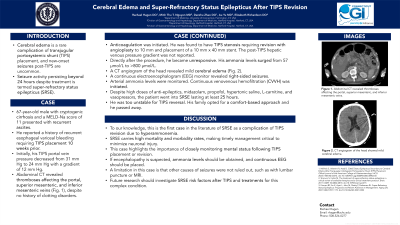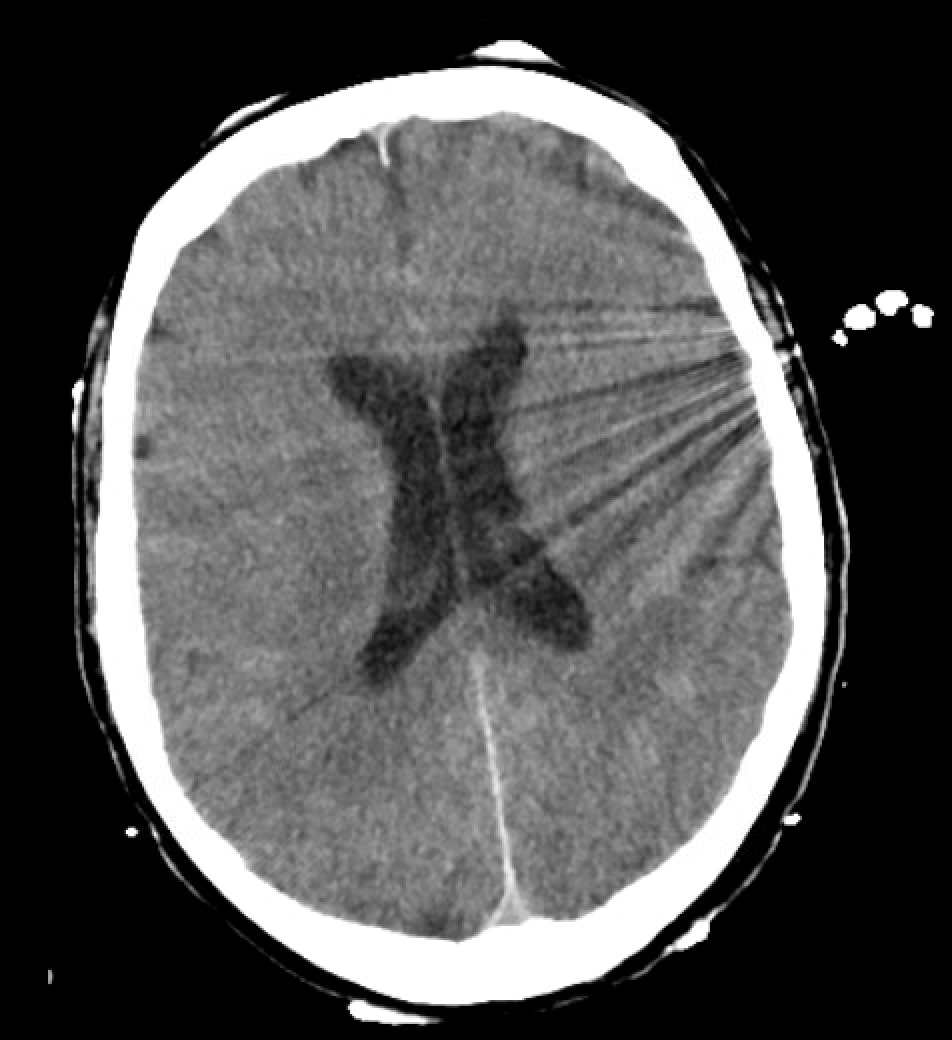Sunday Poster Session
Category: Liver
P1270 - Cerebral Edema and Super-Refractory Status Epilepticus After TIPS Revision
Sunday, October 27, 2024
3:30 PM - 7:00 PM ET
Location: Exhibit Hall E

Has Audio

Rachael Hagen, DO
University of Connecticut Health
Farmington, CT
Presenting Author(s)
Rachael Hagen, DO1, Minh Thu T.. Nguyen, MD2, Danzhu Zhao, DO2, Au Yu, MD3, Elizabeth Richardson, DO3
1University of Connecticut Health, Farmington, CT; 2University of Connecticut Health Center, Farmington, CT; 3Hartford HealthCare, Hartford, CT
Introduction: Cerebral edema is a rare complication of transjugular portosystemic shunt (TIPS) placement, and new-onset seizures post-TIPS are uncommon. Seizure activity persisting beyond 24 hours despite treatment is termed super-refractory status epilepticus (SRSE). Here, we describe a case of hyperammonemia post-TIPS revision leading to cerebral edema and SRSE.
Case Description/Methods: A 67-year-old male with cryptogenic cirrhosis and a MELD score of 11 presented with recurrent ascites. He had a history of recurrent esophageal variceal bleeding requiring TIPS. Initially, his TIPS portal vein pressure decreased from 31 mm Hg to 24 mm Hg with a gradient of 12 but subsequently developed TIPS stenosis. Ten weeks later, abdominal computed tomography (CT) revealed thromboses affecting the portal, superior mesenteric, and inferior mesenteric veins, despite no history of clotting disorders. Anticoagulation was initiated, and he underwent TIPS revision with angioplasty to 10 mm and placement of a 10 mm x 40 mm stent. The post-TIPS hepatic venous pressure gradient was not reported.
Directly after the procedure, he became unresponsive. His venous ammonia levels surged from 57 umol/L to >800 umol/L. A CT angiogram of the head revealed mild cerebral edema. He received hypertonic saline, midazolam, levetiracetam, and L-carnitine. A continuous EEG monitor was placed, and arterial ammonia levels were monitored. Continuous venovenous hemofiltration was also initiated. The EEG revealed right-sided seizures. Despite high doses of anti-epileptics, midazolam, propofol, and vasopressors, the patient went into SRSE lasting at least 25 hours. Per interventional radiology, the patient was too unstable for TIPS reversal. The family opted for a comfort-based approach, and he passed away.
Discussion: To our knowledge, this is the first case in the literature of SRSE as a complication of TIPS revision due to hyperammonemia. SRSE carries high mortality and morbidity rates. Timely management is critical to minimize neuronal injury. This case highlights the importance of closely monitoring mental status following TIPS placement or revision. If encephalopathy is suspected, ammonia levels should be obtained, and continuous EEG should be placed. A limitation is that other causes of seizures were not ruled out, such as with lumbar puncture and magnetic resonance imaging of the brain. Future research should investigate risk factors for SRSE after TIPS and explore treatment modalities for this challenging neurological condition.

Disclosures:
Rachael Hagen, DO1, Minh Thu T.. Nguyen, MD2, Danzhu Zhao, DO2, Au Yu, MD3, Elizabeth Richardson, DO3. P1270 - Cerebral Edema and Super-Refractory Status Epilepticus After TIPS Revision, ACG 2024 Annual Scientific Meeting Abstracts. Philadelphia, PA: American College of Gastroenterology.
1University of Connecticut Health, Farmington, CT; 2University of Connecticut Health Center, Farmington, CT; 3Hartford HealthCare, Hartford, CT
Introduction: Cerebral edema is a rare complication of transjugular portosystemic shunt (TIPS) placement, and new-onset seizures post-TIPS are uncommon. Seizure activity persisting beyond 24 hours despite treatment is termed super-refractory status epilepticus (SRSE). Here, we describe a case of hyperammonemia post-TIPS revision leading to cerebral edema and SRSE.
Case Description/Methods: A 67-year-old male with cryptogenic cirrhosis and a MELD score of 11 presented with recurrent ascites. He had a history of recurrent esophageal variceal bleeding requiring TIPS. Initially, his TIPS portal vein pressure decreased from 31 mm Hg to 24 mm Hg with a gradient of 12 but subsequently developed TIPS stenosis. Ten weeks later, abdominal computed tomography (CT) revealed thromboses affecting the portal, superior mesenteric, and inferior mesenteric veins, despite no history of clotting disorders. Anticoagulation was initiated, and he underwent TIPS revision with angioplasty to 10 mm and placement of a 10 mm x 40 mm stent. The post-TIPS hepatic venous pressure gradient was not reported.
Directly after the procedure, he became unresponsive. His venous ammonia levels surged from 57 umol/L to >800 umol/L. A CT angiogram of the head revealed mild cerebral edema. He received hypertonic saline, midazolam, levetiracetam, and L-carnitine. A continuous EEG monitor was placed, and arterial ammonia levels were monitored. Continuous venovenous hemofiltration was also initiated. The EEG revealed right-sided seizures. Despite high doses of anti-epileptics, midazolam, propofol, and vasopressors, the patient went into SRSE lasting at least 25 hours. Per interventional radiology, the patient was too unstable for TIPS reversal. The family opted for a comfort-based approach, and he passed away.
Discussion: To our knowledge, this is the first case in the literature of SRSE as a complication of TIPS revision due to hyperammonemia. SRSE carries high mortality and morbidity rates. Timely management is critical to minimize neuronal injury. This case highlights the importance of closely monitoring mental status following TIPS placement or revision. If encephalopathy is suspected, ammonia levels should be obtained, and continuous EEG should be placed. A limitation is that other causes of seizures were not ruled out, such as with lumbar puncture and magnetic resonance imaging of the brain. Future research should investigate risk factors for SRSE after TIPS and explore treatment modalities for this challenging neurological condition.

Figure: Figure 1. CT angiogram of the head showed mild cerebral edema.
Disclosures:
Rachael Hagen indicated no relevant financial relationships.
Minh Thu Nguyen indicated no relevant financial relationships.
Danzhu Zhao indicated no relevant financial relationships.
Au Yu indicated no relevant financial relationships.
Elizabeth Richardson indicated no relevant financial relationships.
Rachael Hagen, DO1, Minh Thu T.. Nguyen, MD2, Danzhu Zhao, DO2, Au Yu, MD3, Elizabeth Richardson, DO3. P1270 - Cerebral Edema and Super-Refractory Status Epilepticus After TIPS Revision, ACG 2024 Annual Scientific Meeting Abstracts. Philadelphia, PA: American College of Gastroenterology.
